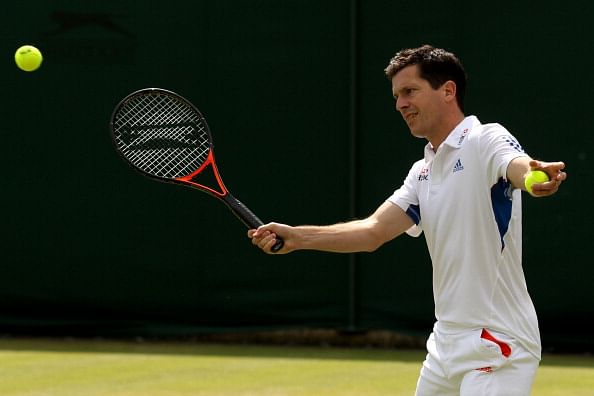
Sad tennis has lost serve and volleyers: Henman
New Delhi, Jan 9 (IANS) The days of Andre Agassi trying to pass the daunting figure of Pete Sampras at the net was one of the most attractive features of tennis – the thrilling serve and volley.
Who can forget those oohs and aahs of a cultured centre court gentry at Wimbledon watching Bjorn Borg trying to muscle his way past a nimble John McEnroe at the net. And then that extraordinary technique of Stefan Edberg, coming in to volley on a not so strong a serve.
Around the time these great character of tennis were enthralling the tennis world, Britain’s Tim Henman showed his prowess as a serve-and-volley exponent, though he belied the hopes of his country folk of becoming only the second player after Fred Perry to win a Grand Slam singles title.
The art has withered away with big, clean hitting from back court dominating the sport.
Heman, who is in Delhi to conduct a clinic for youngsters, bemoaned the loss of the art. The former World No.4 and a four-time Wimbledon semifinalist said fitter, stronger and faster players have made it impossible for the players to rush the net.
“The reality is that the courts and balls are definitely slower now and the way the players moves now, they are physically so much fitter, stronger and faster it is even more difficult to get to the net,” Henman told IANS at the launch of a pilot scheme — ‘HSBC Road to Wimbledon, first Wimbledon event outside the UK.
“It is sad to see the players not willing to charge the net, it is a very difficult thing to do these days.”
The grass courts of Wimbledon at one time were the breeding ground for the serve and volley players. However, with grass getting slowed down to make the rallies longer, the hallowed courts now rarely witness players cutting off the rallies at the net.
“As a serve and volleyer I would love to see more people coming to the net, but seeing today’s tennis as a commentator and as a spectator I find the sport as good as it’s ever been,” he said.
“So its a fine line, maybe in a few years’ time they might make the grass a bit quicker at Wimbledon. Right now I would say the men’s game has never been better.”
All England Club Head Coach Dan Bloxham said the two-handed backhand was one of the key contributors of vanishing serve-and-volley players.
“The match up between the two contrasting styles was one the greatest spectacles this sport has witnessed, but better equipment and double-handed backhand players have killed the art of serve and volley,” Bloxham told IANS.
Bloxham recalled a Wimbledon match in 2010 between John Isner and Nicholas Mahut, the longest in the history, lasting 11 hours and five minutes, as the best example of how slow the grass got.
“The Isner-Mahut match was incredible, but such a long match was unthinkable at Wimbledon five-ten years ago. The grass now is much slower, the rallies much longer with players trying to out-hit each other from the baseline and it’s impossible to volley,” he said.
(Santosh Rao can be contacted at santosh.rians.in)